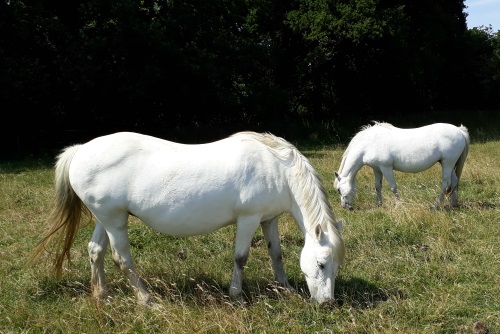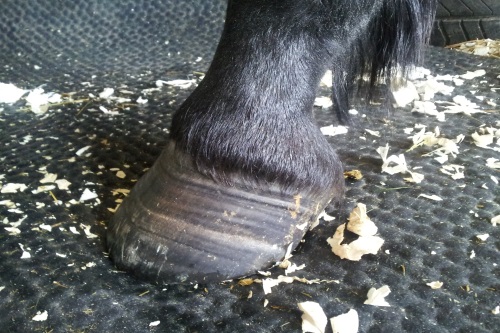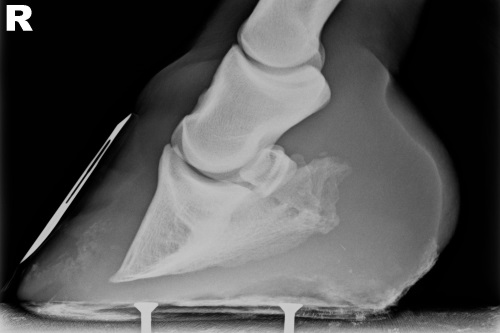
Researching Laminitis Risks for Horses and Ponies
The RVC has been at the forefront of laminitis research for decades and continue to progress advances in the understanding of and treatment of the debilitating condition.

Challenge
Laminitis is a common and extremely painful condition of the equine foot and characterised by failure of the attachment of the epidermal cells of the epidermal (insensitive) laminae to the underlying basement membrane of the dermal (sensitive) laminae. It can occur as a single episode of acute disease or, more commonly, as repeated bouts over a prolonged period.
There are three types of laminitis, namely sepsis-associated, endocrinopathic and supporting limb laminitis. Endocrinopathic laminitis is the commonest form of the disease in the UK, accounting for up to 90% of cases. It encompasses laminitis associated with the two common endocrine diseases equine metabolic syndrome (EMS) and pituitary pars intermedia dysfunction (PPID). The central feature of EMS is insulin dysregulation (ID) and additional features include adipose tissue dysregulation (resulting in altered production of adipose-tissue derived hormones known as adipokines, such as adiponectin) and obesity. The increased risk of laminitis in animals with PPID is also associated with ID.
Endocrinopathic laminitis has been associated with a range of risk factors including metabolic, morphometric and management risk factors. However, further study is required to investigate the relative strength of different risk factors and quantification of risk more precisely requires further study. Identification of animals at an increased risk would allow targeted implementation of management changes that may reduce this risk and thus reduce the frequency of occurrence of this painful disease.

Solution
Endocrinopathic laminitis has been associated with a range of risk factors including metabolic, morphometric and management risk factors. However, further study is required to investigate the relative strength of different risk factors and to precise quantification of risk more precisely requires further study. Following a recent cohort study of non laminitic ponies in Southern England, we reported a one-year baseline risk for the development of laminitis of 4%. The estimated one-year risk increased to 9.3% in ponies with increased basal serum insulin concentration and to 13.9% in those with low plasma adiponectin concentrations. However, there was no benefit in combining these parameters into a clinical prediction model.
Ponies in that cohort study were only sampled on a single occasion once and management data were not collected. Thus, we undertook a second cohort study in which 374 ponies were visited every six months for up to four years. Physical, metabolic and management data were collected, and ponies were monitored for the development of laminitis.
Metabolic data included basal circulating concentrations of ACTH, adiponectin, triglycerides, glucose and insulin and the insulin response to an oral sugar test (OST). Factors significantly associated with laminitis included basal serum insulin concentration, insulin concentration in response to the OST, basal plasma adiponectin concentration and the presence of divergent hoof growth rings on the feet. Low, medium and high laminitis risk groups were defined based on basal insulin or the insulin response to the OST.
Based on basal insulin concentration, low- (<21.6 µIU/ml), medium- (21.6-45.2 µIU/ml) and high- (>45.2 µIU/ml) risk categories encompassed 70, 20 and 10% of the population and had estimated 4-year laminitis incidences (95%CI) of 6 (2-9)%, 22 (10-33)% and 69 (48-82)% respectively. Based on the insulin response to the OST, the low- (<53.4 µIU/ml), medium- (53.4-153 µIU/ml) and high-risk (≥153 µIU/ml) categories comprised 60, 30 and 10% of the population and had estimated 4-year laminitis incidences (95%CI) of 3 (0-6)%, 20 (10-29)% and 73 (52-84)% respectively. Other factors that were associated with laminitis risk included low circulating adiponectin concentrations and the presence of divergent hoof growth rings.
Associations between the insulin response to an oral sugar test and physical and owner-reported variables may help veterinarians select individual animals for ID testing. Further evaluation of the data from this second cohort study revealed that owner-reported and physically apparent variables were limited predictors of the insulin response to an OST and therefore ID. ID may occur in in ponies across a wide range of body conditions, ages and levels of exercise, not just in those that are overweight. However, ID was less common in ponies that undertook more exercise including low-intensity exercise which is something that owners could change to help modify ID and therefore laminitis risk.
A separate study looked back at data collected from three previous studies that had included 734 ponies of different body condition score (BCS) classification (ideal-weight, overweight, and obese), breed, and body shape, with and without a history of laminitis. The results showed that total adiponectin was weakly positively correlated with BCS, height, weight, and weight:height ratio. There were significant differences in adiponectin concentrations in ponies with different BCS group classification, body shape, and breed. More of the obese (54.6%) than ideal-weight ponies had normal total adiponectin concentrations and a greater percentage of ideal-weight (38.6%) than obese ponies showed low adiponectin concentrations. Thus, obesity, despite its significant health hazards, may not be a reliable indicator of poor metabolic health and associated laminitis risk, because lean animals can be at high risk too.

Impact
Researchers at the RVC have been studying laminitis for more than 20 years and were one of the first groups to define endocrinopathic laminitis. They demonstrated that laminitis-prone animals had a metabolic phenotype which included insulin dysregulation (ID), increased circulating triglyceride concentrations and hypertension that was only apparent in the spring/summer rather than in winter, coinciding both with the consumption of spring/summer grass and the time of year at which laminitis risk is increased.
Identification of animals at an increased risk of endocrinopathic laminitis relies on detection of insulin dysregulation. Research at the RVC has demonstrated that either the oral glucose test (OGT) or the oral sugar test (OST) can be used to detect ID manifesting as basal hyperinsulinaemia and/or an excessive insulin response to oral carbohydrate consumption. RVC researchers revealed that these two tests are comparable and measurement of peak circulating insulin concentration following a single feed of glucose or corn syrup provides a simple and practical way of identifying animals at increased risk of laminitis. Further research demonstrated that using a higher than previously recommended dose of commercially available corn syrup (Karo Light corn syrup) for the OST (0.45ml/Kg) is more reliable than a lower dose (0.15ml/Kg).
Adipose tissue dysregulation is an additional feature of equine metabolic syndrome and results in altered production of adipose tissue-derived hormones (adipokines). RVC research has demonstrated that circulating concentrations of the adipokine adiponectin are lower in animals with a history of endocrinopathic laminitis and in healthy animals that go on to develop laminitis in the future. Thus, measurement of adiponectin concentrations is recommended as an additional measure of laminitis risk.
RVC research has demonstrated that two out of the three manifestations of ID are associated with future laminitis risk, with animals in the high-risk category having a 4-year laminitis incidence of 73%. In addition, metabolic health and therefore laminitis risk cannot be predicted from physically apparent, and owner reported variables and obesity is a poor indictors of metabolic health as lean animals are also at a high risk. Thus, assessment of ID-status is recommended in all animals, regardless of age, breed, body shape or husbandry in order to detect animals at the highest risk of developing laminitis in the future.
Partners
The research has been supported by grants from a number of charitable sources including the Horse Trust, the Horse Race Betting Levy Board, BVA Animal Welfare Fund, Norman Hayward Fund, the Laminitis Trust, PetPlan Charitable Trust and RVC Mellon Fund. In addition, research has been undertaken with support from WALTHAM Petcare Science Institute (MARS).
